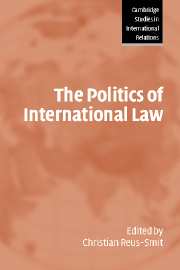Book contents
- Frontmatter
- Contents
- List of contributors
- Preface
- 1 Introduction
- 2 The politics of international law
- 3 When states use armed force
- 4 Soft law, hard politics, and the Climate Change Treaty
- 5 Emerging customary norms and anti-personnel landmines
- 6 International law, politics, and migrant rights
- 7 The International Criminal Court
- 8 The Kosovo bombing campaign
- 9 International financial institutions
- 10 Law, politics, and international governance
- 11 Society, power, and ethics
- Bibliography
- Index
- CAMBRIDGE STUDIES IN INTERNATIONAL RELATIONS
9 - International financial institutions
Published online by Cambridge University Press: 22 September 2009
- Frontmatter
- Contents
- List of contributors
- Preface
- 1 Introduction
- 2 The politics of international law
- 3 When states use armed force
- 4 Soft law, hard politics, and the Climate Change Treaty
- 5 Emerging customary norms and anti-personnel landmines
- 6 International law, politics, and migrant rights
- 7 The International Criminal Court
- 8 The Kosovo bombing campaign
- 9 International financial institutions
- 10 Law, politics, and international governance
- 11 Society, power, and ethics
- Bibliography
- Index
- CAMBRIDGE STUDIES IN INTERNATIONAL RELATIONS
Summary
The International Monetary Fund (IMF) and the World Bank (‘Bank’ or WB), comprise the two major international financial institutions (IFIs). The IFIs exercise enormous power over the workings of the international financial system as reflected in the fact that half the world's population and two-thirds of its governments are bound by the policies they prescribe. This chapter attempts to examine the relationship between law and politics as it manifests itself in the operations of these powerful institutions. Realists view these institutions principally as mechanisms by which powerful states further their own interests. By way of contrast, Beth Simmons, adopting a neoliberal institutionalist approach, studies the IMF in terms of the factors which lead states to co-operate with each other to create a legal regime regulating monetary affairs, the reasons why ‘legalization of monetary relations helps governments make credible policy commitments to market actors,’ and, further, the conditions under which compliance with the system is likely. And Michael Barnett and Martha Finnemore, working within the constructivist school, examine international organisations (IOs) as powerful independent actors and seek to account for the ‘dysfunctional, even pathological, behavior’ of IOs. This approach contends that IOs acquire a life of their own in the course of their operations, and define tasks and functions quite independent of the intentions of the states which created them in the first place.
- Type
- Chapter
- Information
- The Politics of International Law , pp. 217 - 237Publisher: Cambridge University PressPrint publication year: 2004
- 5
- Cited by



